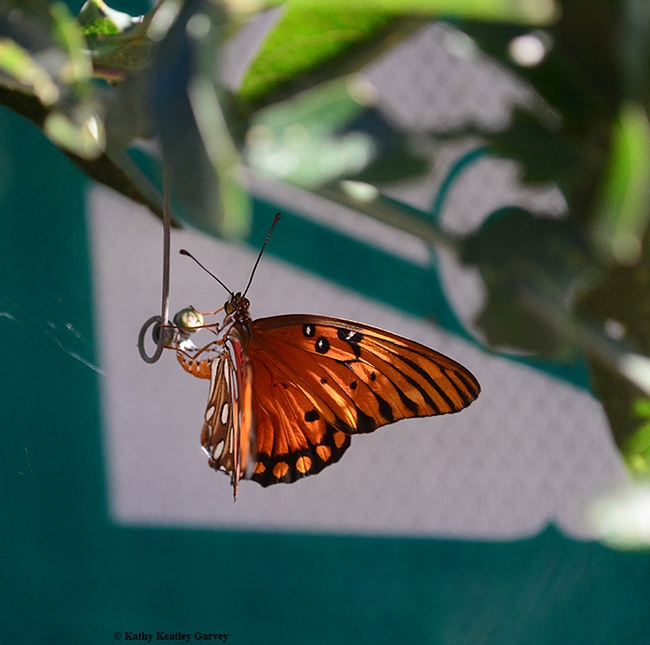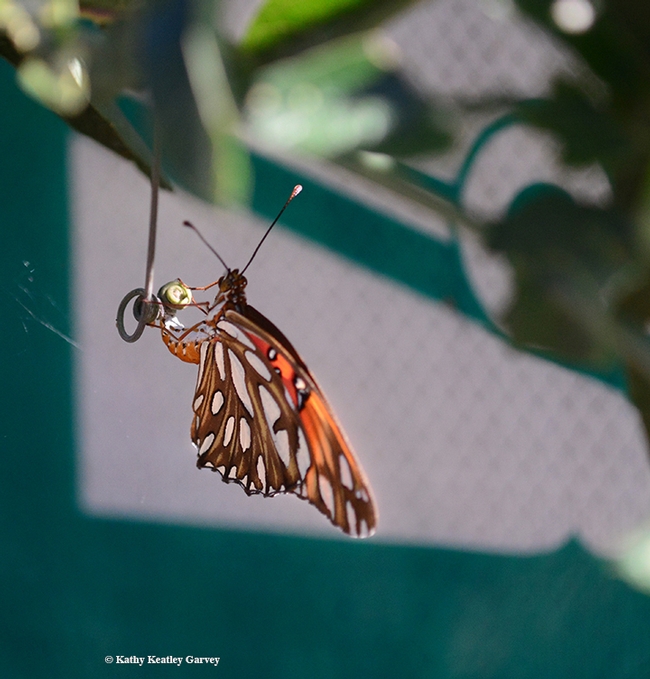- Author: Kathy Keatley Garvey
They brought home five gold or first-place awards: three silver or second-place awards; and two bronze or third-place awards. “That was quite a haul!” commented an ACE member on Facebook.
The recipients:
- Diane Nelson, College of Agricultural and Environmental Sciences, two golds
- Kathy Keatley Garvey, Department of Entomology and Nematology, one gold and one silver
- Jim Downing, California Agriculture journal, gold
- David Slipher, College of Biological Sciences, gold
- Steve Elliott, Western IPM Center, two silvers and a bronze
- Gregory Watry, College of Biological Sciences, bronze
Nelson wrote about pig personalities and polar bears. Slipher's topic was pigeons. (See other topics in the awards news story)
And me--bugs. The news story that won the gold (by yours truly) involved a visit to the Bohart Museum of Entomology by children of California migratory workers.
The piece, “Why These Youngsters Want to Become Entomologists” (https://bit.ly/2sYwhye) covered the children's tour of the insect museum, which houses some eight million insect specimens, a live "petting zoo" (Madagascar hissing cockroaches, walking sticks, tarantulas and praying mantids), and a year around-gift shop. The students engaged the director, Lynn Kimsey, professor of entomology at UC Davis, in a press conference. They asked the "who, what, when, where and how come" questions like pros. It was delightful to see them so well prepared and perceptive.
The Bug Squad blog that won silver (https://bit.ly/2BrePU5) involved a late-season monarch caterpillar that we found Oct. 27, 2017 on one of our milkweeds in our pollinator garden in Vacaville. It formed a chrysalis on Nov. 4.
On Day 19, Nov. 22 (the day before Thanksgiving), it happened. The monarch eclosed. A big, strong and healthy girl.
What to do...no way could she fly three hours in the rain and cold from Vacaville to an overwintering site in Santa Cruz. And with predators abounding, survival looked bleak.
From the Bug Squad blog:
"It just so happened that a friend and pollinator advocate, Rita LeRoy, the self-described 'farm keeper' at the Vallejo City Unified School District's Loma Vista Farm, was heading to Santa Cruz on Friday, the day after Thanksgiving, to show her out-of-town relatives the overwintering migratory butterfly sanctuary at the Natural Bridges State Beach Park. That's about a 100-mile trip from Vallejo.
"Could Ms. Monarch hitch a ride?
"She could. And she did."
Rita is a Monarch Mom (she rears and releases monarchs) and is active in the Bay Area-Based Pollinator Posse. She teaches Vallejo City Unified School District youngsters about farming, cooking and gardening. And that includes gardening for butterflies.
So Ms. Vacaville Monarch hitched a ride with Rita and her family.
"She flew so fast that we didn't get a picture of her flying away," Rita related. "She was anxious to join her new friends."
A happy ending.
And hopefully, Ms. Vacaville Monarch provided the butterfly world with another generation.
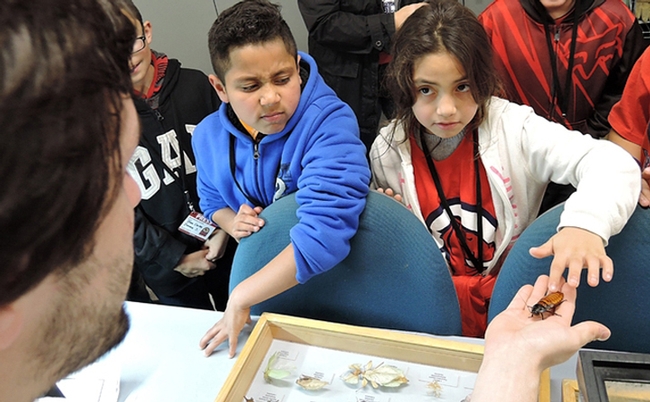
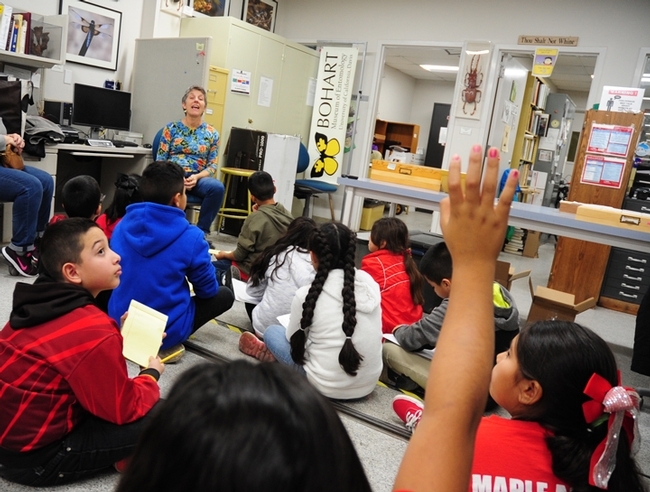
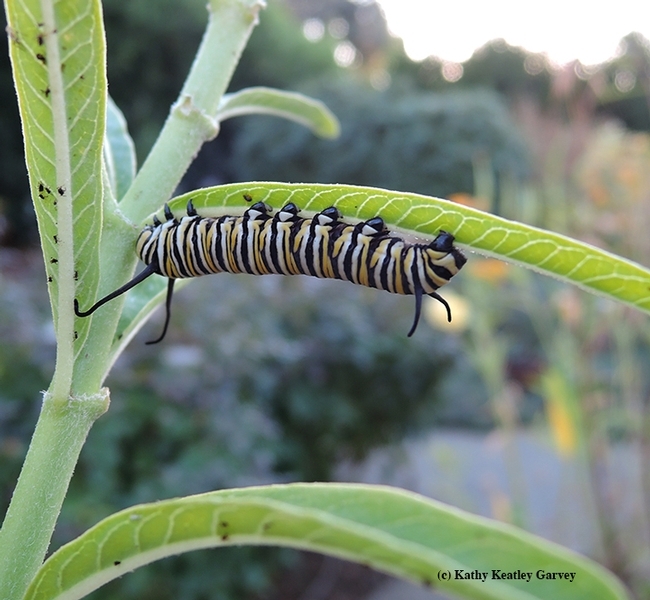
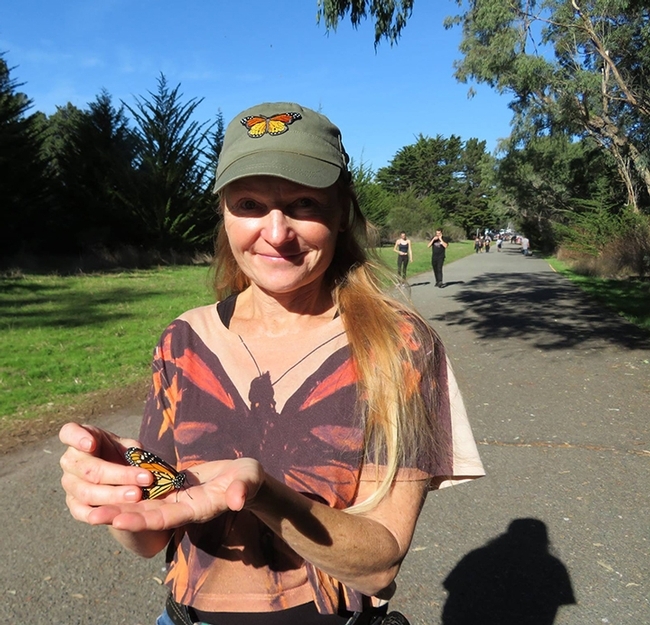
- Author: Kathy Keatley Garvey
The itsy bitsy spider climbed up the water spout.
Down came the rain and washed the spider out.
Out came the sun and dried up all the rain
and the itsy bitsy spider climbed up the spout again.
--Nursery Rhyme
It was an itsy bitsy spider.
But it wasn't climbing up a water spout.
It was lurking, waiting for prey, on our Mexican sunflower.
This particular crab spider was quite visible--white on orange. Sometimes they're so camouflaged that you have to look twice to see them. We remember the perfectly camouflaged crab spider on a gold coin flower (Asteriscus maritimus). (See below).
Crab spiders belong to the family Thomisidae, which includes about 175 genera and more than 2100 species. Wikipedia tells us that "The common name crab spider is often applied to species in this family, but is also applied loosely to many other species of spiders. Among the Thomisidae, 'crab spider' refers most often to the familiar species of 'flower crab spiders,' though not all members of the family are limited to ambush hunting in flowers."
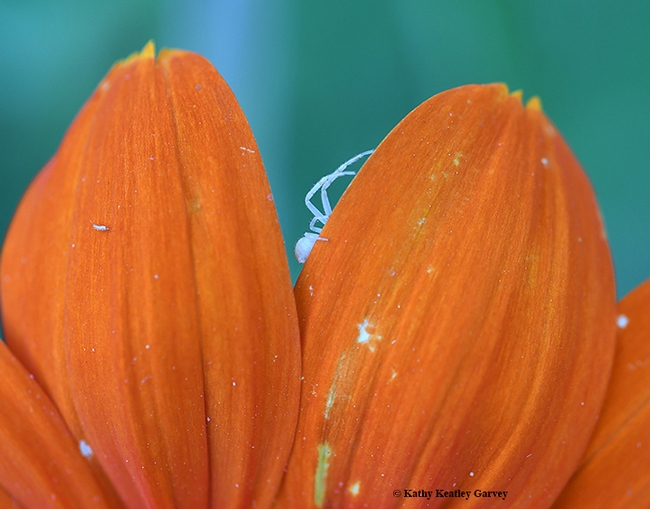
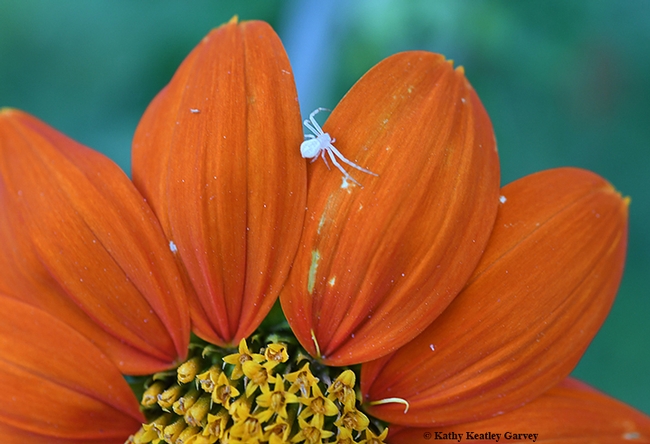
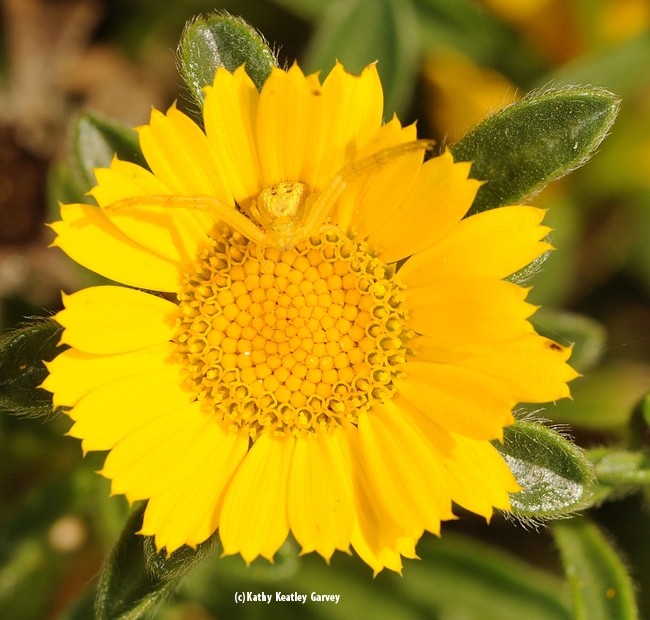
- Author: Kathy Keatley Garvey
Just call it "my old flame."
Well, it's not mine, but it is a flame of sorts, a flame skimmer dragonfly (Libellula saturata) and it's firecracker red.
We see this species frequenting our pollinator garden in Vacaville, which includes a fish pond, flower beds, and bamboo stakes for their perches.
If you like dragonflies, you may want to purchase a dragonfly poster at the gift shop in the Bohart Museum of Entomology, located in Room 1124 of the Academic Surge building on Crocker Lane, UC Davis. It features 18 species of dragonflies, ranging from the common whitetail and green darner to the Western river cruiser and the bison snaketail. And, of course the flame skimmer.
The poster? It's the work of former UC Davis entomology doctoral candidate Fran Keller, now an assistant professor at Folsom Lake College, and naturalist/photographer Greg Kareofelas of Davis. Keller received her doctorate in entomology, studying with Lynn Kimsey, director of the Bohart Museum and professor of entomology at UC Davis.
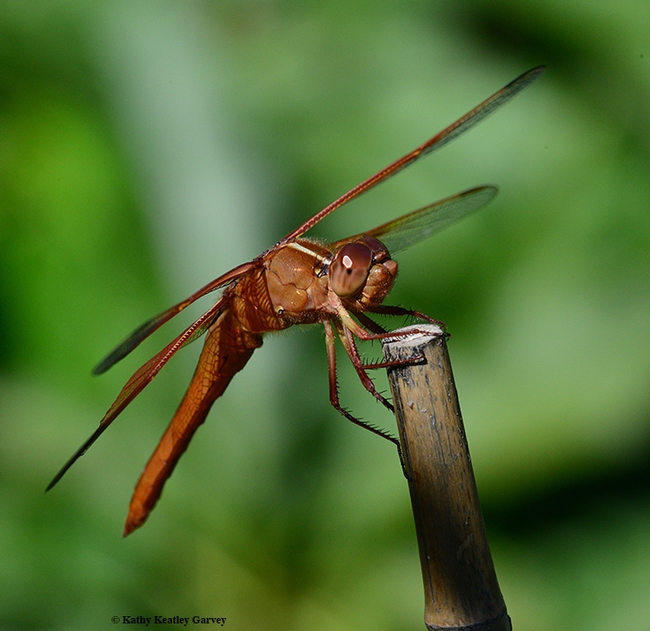
- Author: Kathy Keatley Garvey
Bee-hold, the eye of a bee-holder.
When you have a "Bee Crossing" sign in your pollinator garden, odds are that bees will cross right in front of that sign.
And it's not always a honey bee.
European wool carder bees (Anthidium manicatum) zip around our blue spike sage (Salvia uliginosa), chasing other bees away and trying to save it for "their girls"--per chance to mate with them.
In the photos below, a male European wool carder bee paused to sip some nectar before continuing his rounds.
Little did he know, a honey bee (on the sign) was staring right at him.
As its name implies, the European wool carder bee, Anthidium manicatum, is a native of Europe. American entomologists initially detected his "immigrant ancestor" in the United States (New York) in 1963, and the species spread west. The carder bee (so named because the female "cards" fuzz from plants for her nest) was first recorded in California (Sunnyvale) in 2007.

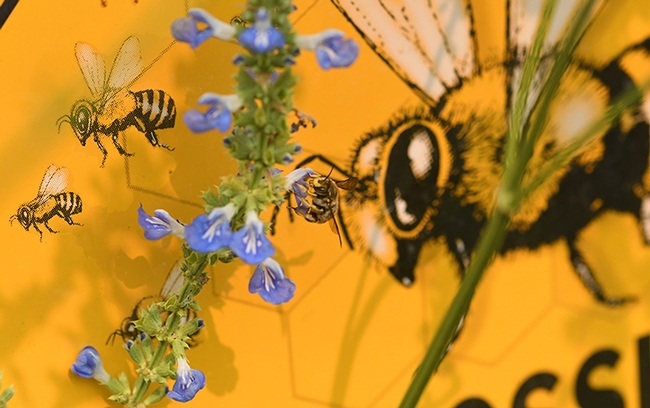
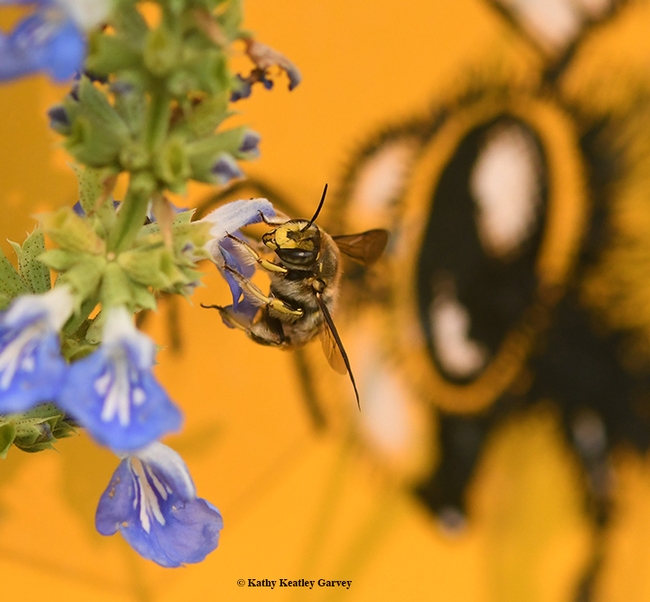
- Author: Kathy Keatley Garvey
Ever seen a Gulf Fritillary butterfly laying an egg?
The Gulf Frit (Agraulis vanillae), an orangish-reddish butterfly of the family Nymphalidae, lays its eggs on its host plant, Passiflora.
When you see its silver-spangled underwings, you may think there are two different butterflies. In the photo below, it's laying eggs on the tendrils of the passionflower vine.
It first appeared in California in the vicinity of San Diego in the 1870s, according to noted butterfly researcher Art Shapiro, professor of evolution and ecology at the University of California, Davis. He's been monitoring the butterflies of central California for four decades and provides information on his website at http://butterfly.ucdavis.edu.
From San Diego, “it spread through Southern California in urban settings and was first recorded in the Bay Area about 1908," says Shapiro. "It became a persistent breeding resident in the East and South Bay in the 1950s and has been there since.”
Shapiro says it “apparently bred in the Sacramento area and possibly in Davis in the 1960s, becoming extinct in the early 1970s, then recolonizing again throughout the area since 2000.”
We never tire of seeing them. Especially the silver-spangled underwings!
